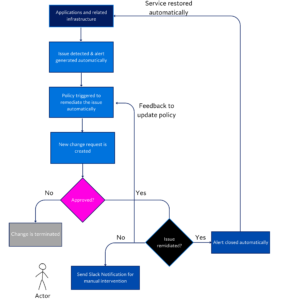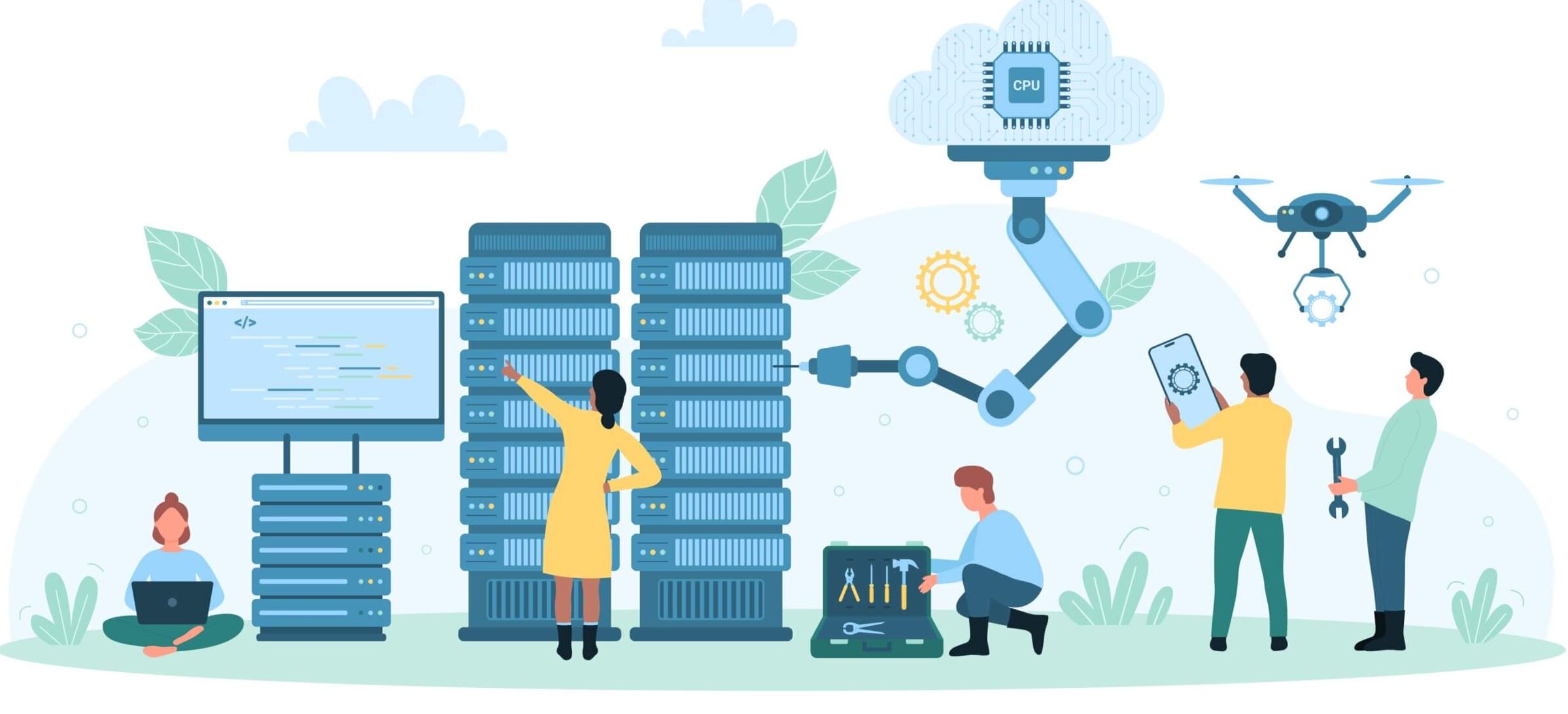Every CIO’s ultimate goal is to create a self-healing enterprise. Self-healing IT systems have the ability to proactively prevent issues within the IT environment, ensuring seamless and uninterrupted services that support business continuity. While automating every possible task seems like an obvious solution, implementing changes in a production environment can be challenging. In most cases, subject matter experts must manually assess the impact of proposed changes across the entire dependency tree before pushing updates to production. Let explore how to begin automating simple changes and take the first steps toward building a self-healing enterprise.
Introduction
Manual alert remediation has long been a standard approach to managing system in IT and security operations, particularly in business-critical environments. However, as modern hybrid systems grow increasingly complex, this traditional method reveals significant shortcomings. It is inherently time-consuming and prone to errors, resulting in inefficiencies and heightened risks.
Key challenges of manual alert remediation include human error, especially during high-pressure situations or extended shifts, where critical details may be overlooked, delaying issue resolution. Slow response times exacerbate these issues, as manual processes hinder both detection and resolution, leading to prolonged downtimes for complex problems. Scalability is another major hurdle, with growing systems and increasing alerts overwhelming IT teams, contributing to burnout and inefficiencies. Additionally, inconsistent handling of alerts by different individuals results in suboptimal solutions and reduced system reliability. These delays and errors expose systems to vulnerabilities and the potential for further destabilization.
Moreover, manual tasks such as logging and documentation waste valuable time, diverting IT teams from more strategic initiatives. Self-healing systems, driven by AI and automation, effectively address these limitations by enabling faster, more consistent, and scalable remediation processes, ensuring resilience in ever-growing IT environments.
What is Self-Healing?
Self-healing refers to AI-driven systems that automatically detect and resolve IT issues without human intervention. By leveraging machine learning algorithms, these systems analyze data, identify anomalies or failures, and take corrective actions to restore normal operations. This minimizes downtime and enhances system reliability.
Benefits of Self-Healing Systems
Self-healing systems offer significant advantages, including reduced downtime by proactively addressing system failures before they escalate or impact end users. They enhance reliability through intelligent, data-driven resolutions that improve system stability. By minimizing manual interventions and reducing incident response times, these systems optimize IT resources, allowing teams to focus on strategic initiatives. Improved user experience is another benefit, as seamless operational continuity is maintained. Additionally, autonomous systems operate 24/7, eliminating the need for Subject Matter Experts to respond to critical issues during off-hours, ensuring consistent availability and efficiency.
Key Components of Self-Healing
The key components of a self-healing system are essential for enabling automated, intelligent detection and resolution of issues in IT environments. These components include:
1. Anomaly Detection
AI-driven algorithms monitor system metrics, identifying anomalies based on historical data and thresholds. Automatically adjust thresholds based on seasonal trends learned over a period.
2. Root Cause Analysis (RCA)
Automated Root Cause Analysis uses correlation across thousands of metrics and pattern recognition to pinpoint issues, such as misconfigurations or resource constraints.
3. Automated Remediation
Predefined actions like restarting services, scaling resources, or executing scripts & workflows are carried out to resolve detected problems. The system learns by itself the effectiveness of the execution of workflows.

How to Get Started
Running automation in a production environment can be daunting, and it’s natural to approach it with caution. Testing the waters with simple, low-risk use cases is an excellent way to build confidence in automation. Here are a few straightforward yet impactful use cases to begin your self-healing journey:
1. Automatic Service Restart
When a critical service stops unexpectedly, the self-healing system detects the issue and restarts the service with minimal downtime, eliminating the need for manual intervention.
2. Dynamic Resource Scaling
During peak loads, if the system encounters high CPU or memory usage, the self-healing system automatically scales resources to maintain optimal performance. This approach ensures balanced performance and cost efficiency.
3. Disk Space Management
If server disk space exceeds critical thresholds, the self-healing system automatically clears temporary files or archives logs. This prevents application crashes and ensures uninterrupted operations.
4. Predictive Maintenance
Using AI-driven observability solutions, self-healing systems can predict hardware failures based on sensor data. This enables proactive replacements and prevents catastrophic downtime.
5. Proactive Security Threat Mitigation
In the event of a security breach, self-healing systems isolate compromised devices or network segments to contain the threat and minimize further damage.
Starting with these use cases allows organizations to gradually embrace automation and build a foundation for more advanced self-healing capabilities.
Pro Tip:
Once the basic tasks are automated, it is highly recommended that you integrate your self-healing systems with ITSM tools like ServiceNow or BMC Remedy to ensure change management approvals before executing automated actions. It helps to track the changes for compliance regulations, and critical changes are deployed only if they are approved.
Start Small
Implementing self-healing systems can deliver significant benefits, but success requires a thoughtful, phased approach. Instead of trying to tackle everything at once, focus on setting achievable goals and tracking progress regularly. Avoid rushing the process and ensure your tools are optimally configured to detect thresholds. Thoroughly test automation scripts for various scenarios before deploying them in a production environment.
Here’s a recipe for success: Begin with a single, simple & low-risk use case that occurs frequently. Test it rigorously, deploy it in production, and once it’s running smoothly, gradually expand to other use cases. This incremental approach builds confidence, minimizes risks, and lays the foundation for broader automation adoption.
The Virtana Advantage
If you’re searching for a tool to help automate your processes, consider the Virtana AI-driven platform. With Virtana, you can:
Identify Anomalies: Virtana’s dynamic alert thresholding automatically adjusts thresholds based on the behavior of specific metrics over time. This adaptive monitoring ensures alerts are triggered only for significant deviations, improving accuracy and responsiveness. You can configure alarms with parameters like thresholds, windows, and severity and set up notifications to promptly alert users when these thresholds are breached.
Automate Root Cause Analysis and Troubleshooting: Using open LLM technology, the Virtana platform quickly identifies the root causes of alerts and displays corresponding metrics to help you analyze and resolve specific issues efficiently.
Define and Execute Custom Policies for Automated Responses: Virtana allows you to create custom policies to define workflows and criteria for automated responses. These policies ensure workflows are executed when specific conditions are met, streamlining the response process.
With these features, Virtana empowers you to automate processes, enhance system reliability, and respond to issues more effectively.
Conclusion
We live in an era driven by automation, where AI-powered advancements—ranging from self-driving cars to robotic chefs—are transforming the way we operate. IT Operations teams must harness the power of AI and automation to stay ahead. Self-healing systems represent the future of IT operations, enabling organizations to proactively resolve issues, reduce downtime, and enhance system reliability. By adopting AI, automation, and machine learning, businesses can unlock the full potential of self-healing systems, achieving greater efficiency and resilience in their IT environments.
About the Author
Meeta Lalwani is a director of product management professional leading the AIOps (Artificial Intelligence for IT Operations) and GenAI Portfolio for the SaaS (Software as a Service) platform at Virtana. She is passionate about modern technologies and their potential to positively impact human growth.
Meeta Lalwani




